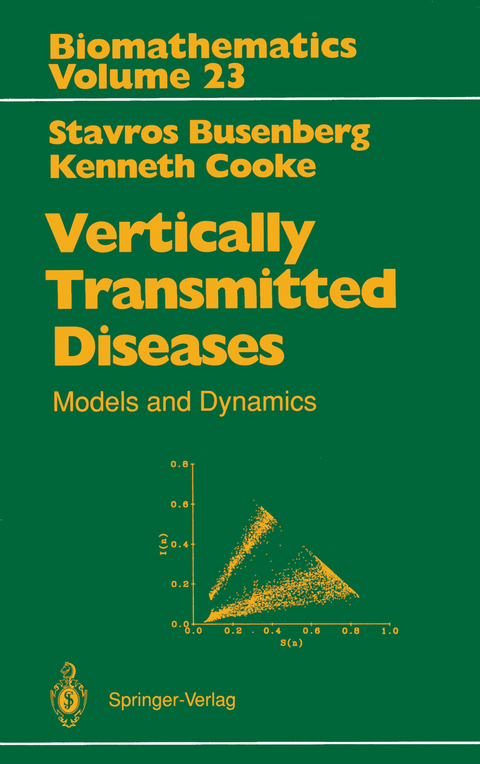
Vertically Transmitted Diseases
Springer Berlin (Verlag)
978-3-642-75303-9 (ISBN)
Infectious diseases are transmittable through different mechanisms. Vertical transmission occurs when a parent transmits a disease to an unborn offspring. The epidemiology of such transmissions can be very complicated, and hence also the modelling and analysis leading up to strategies for control and prevention. The book describes current methods for formulating models and analyzing the dynamics of the propagation of diseases which include vertical transmission as one of the mechanisms for their spread. No previous background in disease transmission modeling and analysis is assumed and the required biological concepts and mathematical methods are gradually introduced within the context of specific disease transmission models. Graphs are widely used to illustrate and explain the modeling assumptions and results.
1 Introduction.- 1.1 What is Vertical Transmission?.- 1.2 Methodology, Terminology and Notation.- 1.3 Examples of Vertically Transmitted Diseases.- 1.4 Organization and Principal Results.- 2 Differential Equations Models.- 2.1 A Classical Model Extended.- 2.2 Some Biological and Modeling Considerations.- 2.3 Model Without Immune Class.- 2.4 Discussion of the Global Result.- 2.5 Proofs of the Results.- 2.6 No Horizontal Transmission.- 2.7 The Model with Immune Class.- 2.8 The Case of Constant Population.- 2.9 A Model with Vaccination.- 2.10 Models with Latency or Maturation Time.- 2.11 Models with Density Dependent Death Rate.- 2.12 Parameter Estimation.- 2.13 Models of Chagas' Disease.- 2.14 An SIRS Model with Proportional Mixing.- 2.15 Evolution of Viruses.- 2.16 The Mathematical Background.- 3 Difference Equations Models.- 3.1 Introduction.- 3.2 A Model for the Transmission of Keystone Virus.- 3.3 Population Size Control via Vertical Transmission.- 3.4 Vertical Transmission in Insect Populations.- 3.5 Logistic Control in the Reproduction Rate.- 3.6 Logistic Control through the Death Terms.- 3.7 Mathematical Background.- 4 Delay Differential Equations Models.- 4.1 The Role of Delays in Epidemic Models.- 4.2 A Model with Maturation Delays.- 4.3 Delays Due to Partial Immunity.- 4.4 Delay Due to an Incubation Period.- 4.5 A Model with Spatial Diffusion.- 4.6 Diseases with Long Subclinical Periods.- 4.7 Mathematical Background.- 5 Age and Internal Structure.- 5.1 Age Structure and Vertical Transmission.- 5.2 Modeling Internal Structure.- 5.3 Derivation of the Model Equations.- 5.4 Age Structure and the Catalytic Curve.- 5.5 An s ? i Model with Vertical Transmission.- 5.6 Analysis of the Intracohort Model.- 5.7 Analysis of the Intercohort s ? i ? s Model.- 5.8Numerical Simulations.- 5.9 Global Behavior of the s ? i ? s Model.- 5.10 Destabilization Due to Age Structure.- 5.11 Thresholds in Age Dependent Models.- 5.12 Spatial Structure.- 5.13 The Force of Infection Terms.- References.- Author Index.
| Erscheint lt. Verlag | 27.12.2011 |
|---|---|
| Reihe/Serie | Biomathematics |
| Zusatzinfo | XI, 248 p. |
| Verlagsort | Berlin |
| Sprache | englisch |
| Maße | 155 x 235 mm |
| Gewicht | 405 g |
| Themenwelt | Informatik ► Weitere Themen ► Bioinformatik |
| Mathematik / Informatik ► Mathematik ► Angewandte Mathematik | |
| Medizin / Pharmazie ► Medizinische Fachgebiete | |
| Studium ► Querschnittsbereiche ► Epidemiologie / Med. Biometrie | |
| Schlagworte | Dynamics • Endemic Thresholds • Epidemic models • Infection • Infectious Diseases • Mathematics • Nonlinear Systems • population dynamics • Vaccination • Vertical transmission |
| ISBN-10 | 3-642-75303-5 / 3642753035 |
| ISBN-13 | 978-3-642-75303-9 / 9783642753039 |
| Zustand | Neuware |
| Haben Sie eine Frage zum Produkt? |
aus dem Bereich


